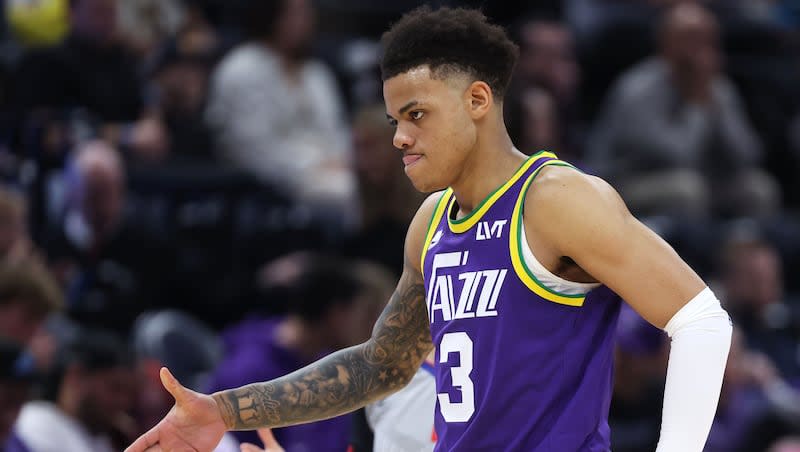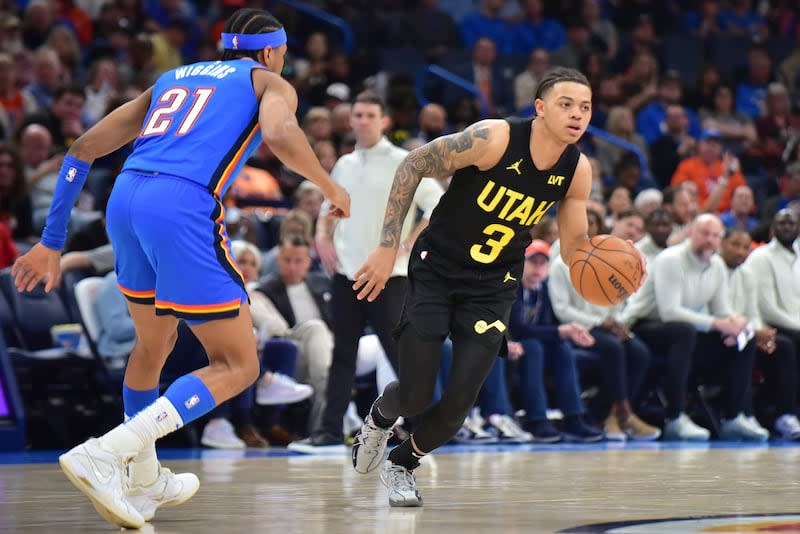Where does Keyonte George figure into the Jazz’s future success?

When the Utah Jazz selected Keyonte George 16th overall out of Baylor in the 2023 draft, the plan was not necessarily for him to play at point guard, and it certainly wasn’t for him to start 44 of the team’s 82 games as the point guard.
If we’re all being honest, George’s negative assist-to-turnover ratio at Baylor, while playing on the wing, was more of a sign that he would not be handling the majority of facilitating duties for the Jazz. But things changed quite a bit after George’s Summer League performances and what he was able to do during training camp.
Not only did it become clear that George was more ready for NBA action than fellow rookies Taylor Hendricks and Brice Sensabaugh, it was also clear that George was capable of running point, a position that was brand new for his basketball career.
“It wasn’t our plan for him to be a starter going into training camp,” Jazz CEO Danny Ainge said. “But he was good. He was a good player, he earned the respect of the coaches and his teammates and he earned that job. It wasn’t given to him.”
In fact, the Jazz held off as long as they could before giving George an increased role. Even as word was leaking out from the Jazz front office and coaching staff that many believed George could be the team’s point guard of the future, Talen Horton-Tucker started at point for the first eight games of the season. Then, on George’s 20th birthday, he was moved into the starting lineup.
There was a lot of early hype around the potential of the rookie early in the season. He was playing as if point guard was his natural position. After getting the starting job and through mid-December, George was averaging an incredibly respectable 12.7 points per game while dishing out 5.9 assists with just 2.6 turnovers. Then, a minor foot injury sidelined him for nearly two weeks.
During that time, it was clear that Collin Sexton was making some huge strides and marked improvement. Additionally, veteran Kris Dunn was humming in the backcourt with Sexton, while finding some really good chemistry with Lauri Markkanen and John Collins, while Simone Fontecchio continued to show he was better than had been expected. The Jazz had found a nice balance with the starting lineup, so when George returned from injury, he came off the bench but still had a big role on the team.
George was maintaining a steady diet of facilitating and scoring, and considering that he was a 20-year-old rookie, he was handling everything really well while also finding ways to tweak his game and getting up to speed with how things are done in the NBA. If we’re looking to break up the segments of the season when analyzing George’s rookie season, the buildup and first 16 games he started serve as a perfect first segment. His continued improvement and solid play after returning from injury are the clear second segment of the season.
Then came the trade deadline.
The Jazz once again depleted the roster midseason in favor of better lottery odds. George started the remaining games on the 2024 calendar, save the one game when he was sick. But he was not running point for the same team he’d played with early on. Instead, it was a nightly toss-up of what the rotations might look like.
One night would include Markkanen, Jordan Clarkson and Collins, another night he might be alongside Sexton, or Horton-Tucker and as the season progressed you could expect all three rookies to start alongside some of the Jazz’s two-way players and end-of-bench guys. So, rather than be a rookie who was maybe the fourth or fifth player on an opposing scouting report, George was thrust into not only the starting point guard role, but also as the No. 1 guy on a scouting report, which was arguably a role that George was not ready for.
“He played point guard for the first time in his life this year, and he was a full-time NBA point guard,” Ainge said. “And half the games he played this year, he’s the focal point of the opposition defense.”
During that final stretch of games — the third segment of George’s rookie season — he was required to be more of a scorer, more of a creator for himself. Though his confidence shooting the ball rose, he also saw an understandable decrease in assists and uptick in turnovers. But can we really fault him for that? Can we even properly critique this part of the season?
“It’s hard, because there is a lot of context,” Jazz coach Will Hardy said. “You want to be in a role that you can handle and I think that there were moments where (the rookies) were probably getting too much. And that’s just kind of the situation that we were in. That’s not their fault. It’s no one’s fault. So yeah, there’s parts of it that I have to sort of just block out because it’s a little noisy ... so it does make it hard for me to evaluate. ... What parts are within their control? And what parts am I’m putting them in a situation where maybe they’re just not quite ready?”
“It wasn’t our plan for him to be a starter going into training camp. But he was good. He was a good player, he earned the respect of the coaches and his teammates and he earned that job. It wasn’t given to him.”
Jazz CEO Danny Ainge
With all of that in mind, it’s probably more fair to George to really only consider the first two-thirds of the season when trying to figure out what kind of a player he can be for the Jazz as they move forward through the rebuild.
“He’s way better now than he was to start the season,” Ainge said. “I’m still not sure he’s a franchise point guard. I think he can play point guard. I think that he can play with another guard playing the point and he can play off the ball. As a matter of fact, he’s probably more comfortable with that at this moment in time. But this experience of learning the point guard position was a big step for him. And just provides a lot of versatility for our team going forward.”
Though some people might see or hear this quote from Ainge and think that it skews unfavorably for George — as if he’s disappointed in his ability to be a franchise point guard — I think that the most important thing that Ainge said was, “I’m not sure.”
George played in 47 games prior to the trade deadline. He showed flashes of someone that might be able to handle lead guard duties for a team that is composed of the right talent and skill level to play competitively throughout the season. He showed the ability to create at a high level and when he talked about his priorities on the court during that time, he sounded wise beyond his years.
But 47 games is hardly a big enough sample size to make final determinations about the kind of basketball player that George can be going forward. So, this is all context and data that will have to be considered in the 2024-25 season. George could still end up being the Jazz point guard of the future, but to make any full sweeping declaration right now about his potential or abilities would probably be shortsighted, considering how the Jazz’s season unfolded.


